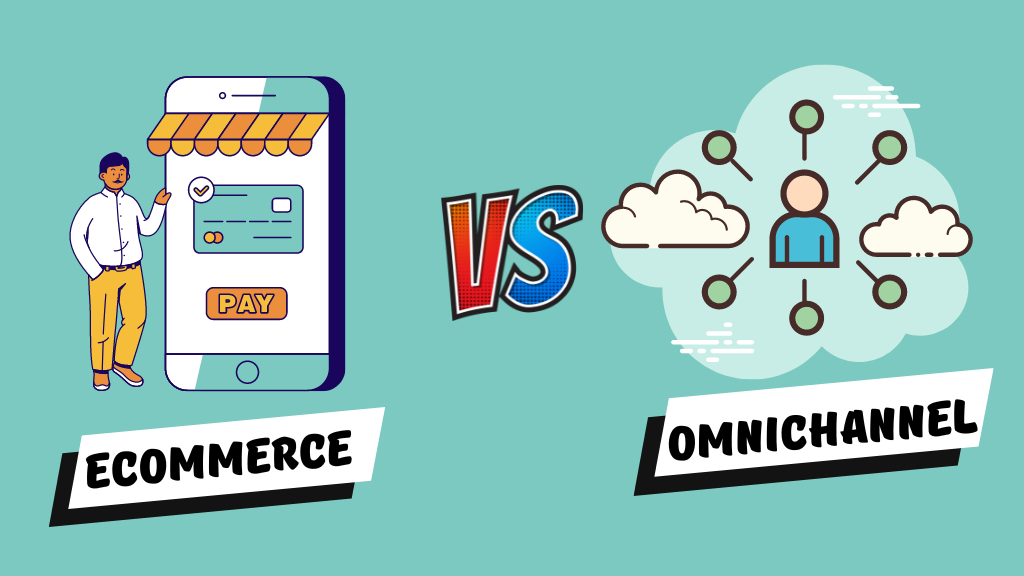Omnichannel eCommerce has become an increasingly popular strategy for retailers to provide a seamless shopping experience for their customers across multiple channels. In this article, we will explore Omnichannel eCommerce and how to leverage Omnichannel eCommerce to optimize your customer experience in your business.
What is Omnichannel eCommerce?
Omnichannel eCommerce is a sales strategy that provides customers with a consistent shopping experience across all channels, whether online or offline. It is an approach that integrates all touchpoints of the customer journey, from browsing products to completing the purchase, regardless of the channel used, such as a physical store, website, social media, mobile app, or marketplace.
Omnichannel eCommerce Development is to provide a seamless, integrated, personalized shopping experience meeting customers’ expectations and preferences.
Difference between Omnichannel and eCommerce?

E-commerce and omnichannel are related concepts in the world of retail and digital commerce, but they are not interchangeable terms. Here are the main differences between these two concepts:
Scope
E-commerce refers specifically to the buying and selling of goods and services over the Internet, while omnichannel eCommerce encompasses multiple channels and touchpoints through which customers can interact with a business, both online and offline.
Integration
An eCommerce typically involves a standalone online store that is separate from other channels, while omnichannel commerce involves integrating all customer touchpoints, including online and offline stores, social media, mobile apps, and more.
Customer Experience
An E-commerce platform typically focuses on the online shopping experience, while omnichannel eCommerce focuses on creating a seamless and consistent customer experience across all touchpoints, both online and offline.
Data and Analytics
Omnichannel eCommerce requires businesses to collect and analyze data from multiple channels in order to optimize their customer experience, while eCommerce may focus more on online metrics such as website traffic and conversion rates.
Overall, while eCommerce is an important aspect of omnichannel commerce, it is just one piece of the larger puzzle. Omnichannel eCommerce requires businesses to adopt a holistic approach to customer engagement and sales that integrates multiple touchpoints and channels.
Benefits of Omnichannel eCommerce

Omnichannel commerce offers several benefits for businesses that adopt this approach. Adopting an omnichannel commerce approach can provide businesses with a range of benefits, from increased sales and revenue to improved customer satisfaction and loyalty. Here are some of the key benefits:
Improved Customer Experience
Omnichannel eCommerce provides customers with a seamless and personalized shopping experience across multiple channels and touchpoints. This can lead to increased customer satisfaction, loyalty, and repeat business.
Increased Sales and Revenue
By offering customers a variety of channels to complete their purchases, businesses can capture more sales and revenue.
Competitive Advantage
In today’s competitive retail landscape, offering an omnichannel experience can help businesses stand out from the competition and attract new customers.
Data and Analytics
Omnichannel eCommerce provides businesses with valuable data and insights into customer behavior across different channels. This can be used to optimize marketing and sales strategies, as well as to personalize the shopping experience for individual customers.
Increased Efficiency and Cost Savings
By integrating all customer touchpoints and channels, businesses can streamline their operations and reduce costs associated with managing multiple channels separately.
5 steps to boost user experience on Omnichannel

By following these five steps above, businesses can create a seamless and personalized omnichannel shopping experience that can lead to increased sales, customer loyalty, and brand advocacy. However, to optimize your Omnichannel eCommerce platform, businesses need a reputable eCommerce development unit to implement your desire.
Here are five steps retailers can take to enhance the user experience on omnichannel eCommerce:
Step 1: Create a cohesive brand experience across all channels
In order to provide a seamless experience for customers, businesses should strive to create a cohesive brand experience across all channels, including online and offline stores, social media, mobile apps, and more. This can be achieved by using consistent branding, messaging, and design elements across all touchpoints.
Step 2: Implement a unified inventory system
A unified inventory system can help businesses ensure that products are available for purchase across all channels, and can prevent overselling or stockouts. This can be achieved by integrating inventory data across all channels so that customers can see real-time product availability.
Step 3: Use data to personalize the shopping experience
By collecting and analyzing customer data across all channels, businesses can personalize the shopping experience for individual customers. This can include personalized product recommendations, targeted promotions, and more.
Step 4: Offer flexible fulfillment options
In order to meet the needs of customers who want to shop across multiple channels, businesses should offer flexible fulfillment options, such as buying online, picking up in-store (BOPIS), or shipping from the store. This can help to reduce delivery times, and shipping costs, and improve customer satisfaction.
Step 5: Provide excellent customer service
Businesses should prioritize providing excellent customer service across all channels. This can include offering multiple channels for customer support, such as phone, email, and live chat, as well as providing quick response times and personalized support.
What’s Next in Omnichannel eCommerce?

The future of omnichannel eCommerce looks bright, with new technologies and strategies emerging all the time. As retailers continue to adapt and evolve their omnichannel strategies, customers can look forward to a more personalized, convenient, and sustainable shopping experience.
Personalization
Personalization will continue to be a key trend in omnichannel eCommerce, as retailers look for new ways to tailor their offerings to individual customers. By leveraging customer data and advanced analytics, retailers can provide personalized recommendations, offers, and promotions that are tailored to each customer’s unique preferences and behaviors.
Integration of emerging technologies
Emerging technologies such as virtual reality, augmented reality, and voice assistants are becoming more prevalent in omnichannel eCommerce. Retailers are using these technologies to enhance the customer experience and provide new and innovative ways for customers to interact with their products.
Enhanced data analytics
As more retailers adopt omnichannel eCommerce strategies, the amount of customer data available to them will continue to grow. To make sense of this data and use it effectively, retailers will need to invest in advanced data analytics tools and technologies.
Seamless payment solutions
Payment options have always been an important part of the shopping experience, but they are becoming even more important in omnichannel eCommerce platforms. Retailers are increasingly offering flexible payment options such as mobile wallets and buy now, pay later solutions to make the checkout process more seamless and convenient for customers.
Sustainability and social responsibility
Customers are becoming more conscious of the environmental and social impact of their purchasing decisions. As a result, retailers are focusing on sustainability and social responsibility in their omnichannel commerce strategies. This includes using sustainable materials, reducing waste, and supporting social causes that align with their brand values.
Conclusion
Omnichannel eCommerce has become an essential strategy for retailers to provide a seamless shopping experience for their customers across multiple channels. By offering a cohesive and personalized shopping experience, retailers can improve customer engagement, increase sales, and build customer loyalty. By following the five steps outlined in this article, retailers can enhance the user experience on omnichannel eCommerce and reap the benefits it provides. Contact us today!
Read also:
M-commerce vs eCommerce: The comparison brings to you the most comprehensive look
Top best B2B ecommerce platform to scale your B2B business rapidly
